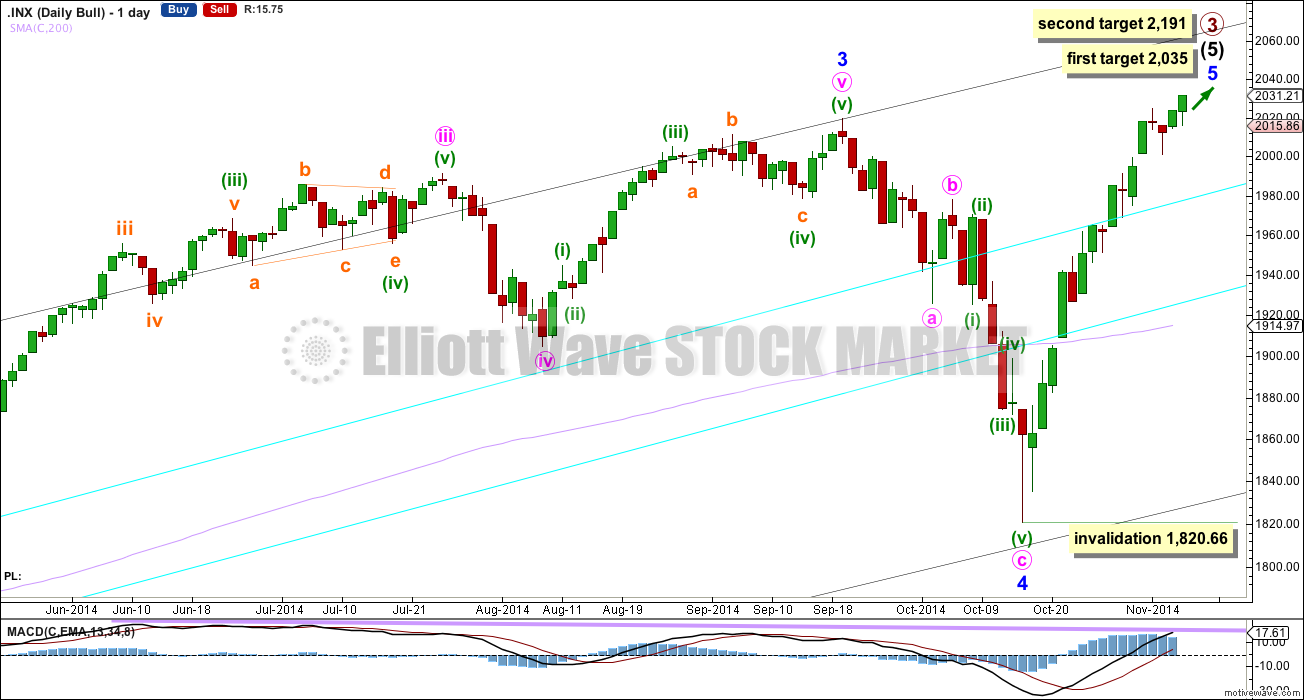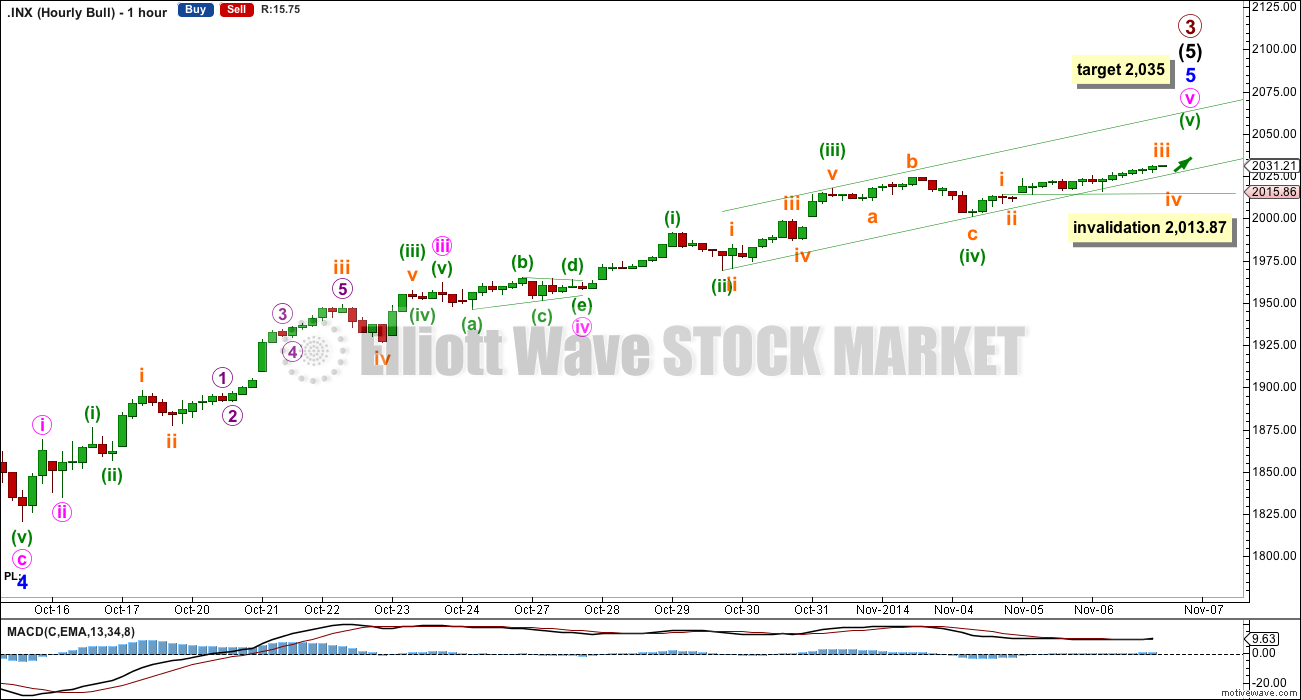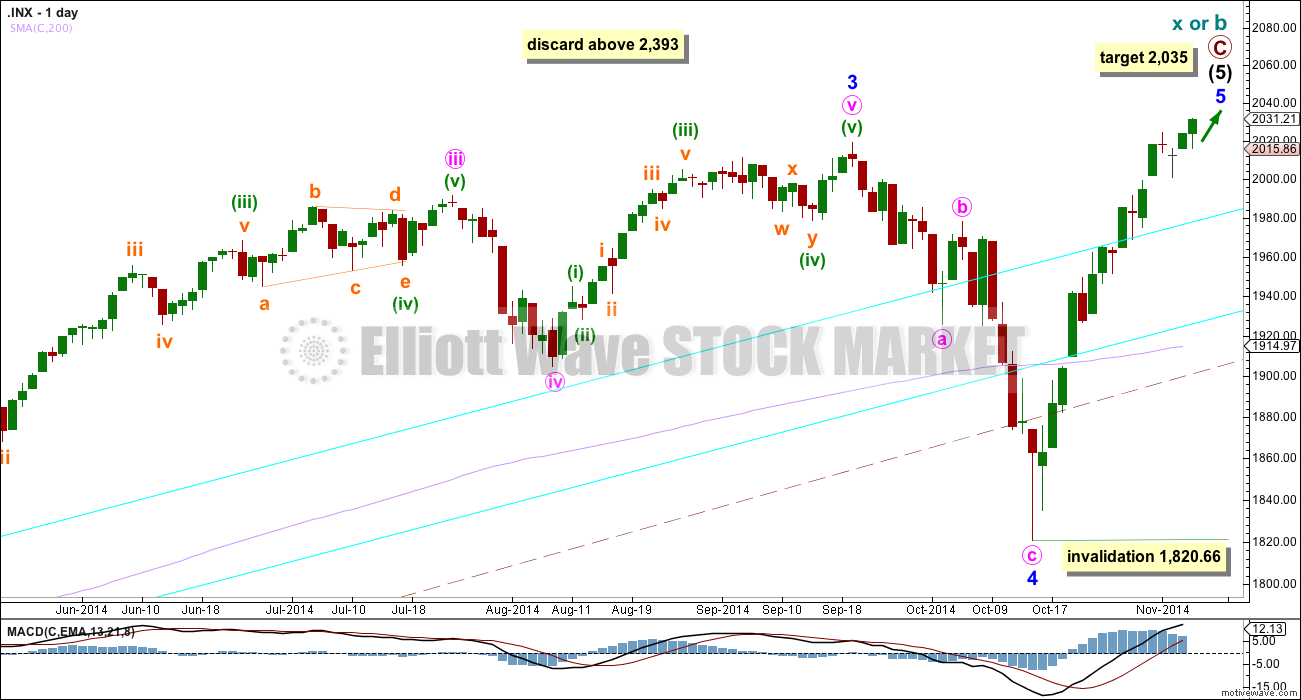Another green candlestick was expected and fits both Elliott wave counts perfectly.
Summary: The first target for this upwards movement to end is at 2,035. If price keeps going up through this first target the next target is at 2,191, although this has a low probability.
Click on charts to enlarge.
Bull Wave Count
I will favour neither the bull or bear wave count. Both are viable and both expect this current upwards impulse to end. When the trend change arrives I will be looking at the structure and depth of downwards movement to determine which wave count is correct.
To see a weekly chart with subdivisions and how to draw trend lines and channels click here.
Upwards movement from the low at 666.79 subdivides as an almost complete 5-3-5. For the bull wave count this is seen as primary waves 1-2-3.
Within intermediate wave (5) minor wave 2 is an expanded flat and minor wave 4 is a zigzag. Minor wave 3 is 14.29 points longer than 1.618 the length of minor wave 1. Because there is already a close Fibonacci ratio between minor waves 3 and 1 I would not expect to see a Fibonacci ratio for minor wave 5.
At intermediate degree there is also a very close relationship between intermediate waves (3) and (1): intermediate wave (3) is just 0.76 points less than 2.618 the length of intermediate wave (1). I would not expect to see a ratio for intermediate wave (5) to either of (1) or (3).
The aqua blue trend lines are traditional technical analysis trend lines. These lines are long held, repeatedly tested, and shallow enough to be highly technically significant. When the lower of these double trend lines is breached by a close of 3% or more of market value that should indicate a trend change. It does not indicate what degree the trend change should be though.
There is now double technical divergence between MACD and price at the weekly chart level.
There is also technical divergence between price and MACD at the daily chart level.
Within minor wave 5 no second wave correction may move beyond the start of its first wave below 1,820.66.
When this final upwards impulse of minor wave 5 is a complete structure I will have an alternate wave count which moves the degree of labelling within minor wave 5 all down one degree, because a five upwards structure may be just minute wave i within minor wave 5.
Minor wave 5 may extend, and this idea fits with the second target. The first target is calculated at the hourly chart level, and price may find resistance at the upper edge of the black channel.
At 2,191 primary wave 3 would reach 1.618 the length of primary wave 1. This would see intermediate wave (5) and minor wave 5 within it both extended. This is possible, but unlikely. Continuing divergence at the weekly and daily chart levels indicates this wave may end sooner.
Minuette wave (v) remains contained within the lower half of the channel. At this stage subminuette wave iii within it looks incomplete on the five minute chart. It should be done very soon. Thereafter, subminuette wave iv may not move into subminuette wave i price territory below 2,013.87.
Because there is already a close Fibonacci ratio between minute waves iii and i (minute wave iii is just 0.38 points longer than 2.618 the length of minute wave i) I would not expect to see a Fibonacci ratio between minute wave v and either of i or iii. The target is best calculated at minuette wave degree.
The target remains the same. At 2,035 minuette wave (v) would reach equality in length with minuette wave (i).
This upwards movement could end tomorrow.
Bear Wave Count
This bear wave count differs from the bull wave count at the monthly chart level and at super cycle wave degree. To see the historic picture go here.
The subdivisions within primary waves A-B-C are seen in absolutely exactly the same way as primary waves 1-2-3 for the bull wave count.
For both wave counts when minor wave 5 is a complete structure on the hourly and five minute charts then I will have an alternate wave count which moves the degree of labelling within it all down one degree. A completion of a five wave impulse up within minor wave 5 may be either minor wave 5 in its entirety, or it may only be minute wave i within minor wave 5. This is why I am leaving the invalidation point at 1,820.66.
At cycle degree wave b is over the maximum common length of 138% the length of cycle wave a, at 157% the length of cycle wave a. At 2,393 cycle wave b would be twice the length of cycle wave a and at that point this bear wave count should be discarded.
This analysis is published about 07:42 p.m. EST.




